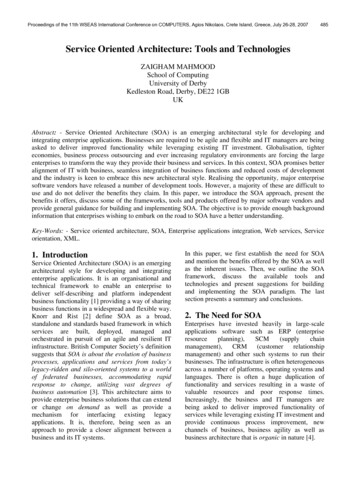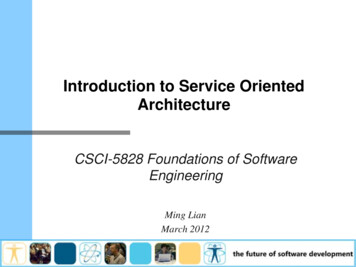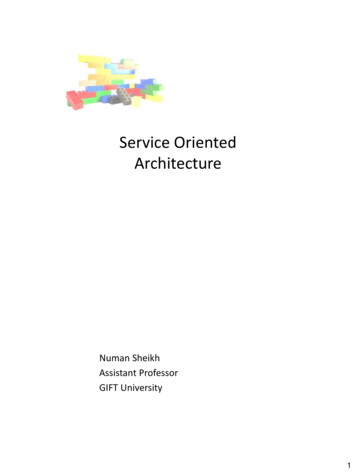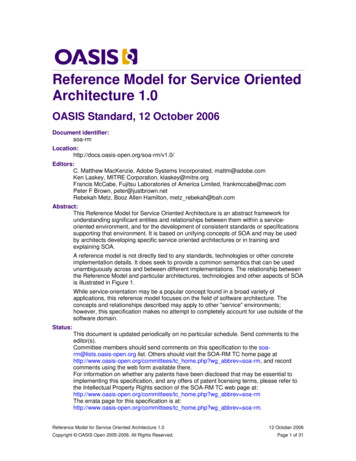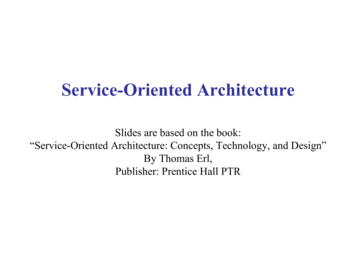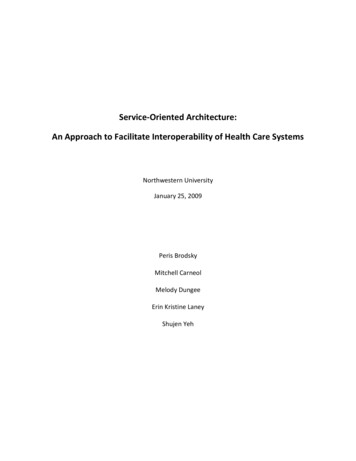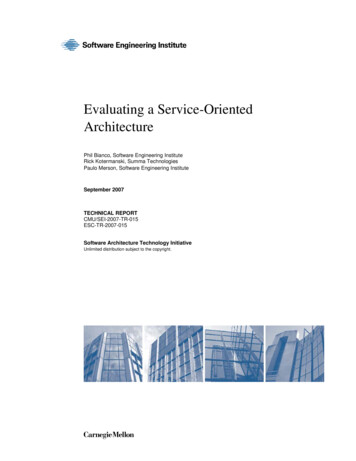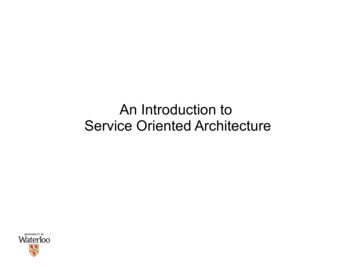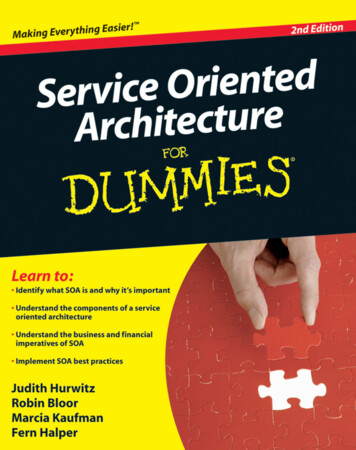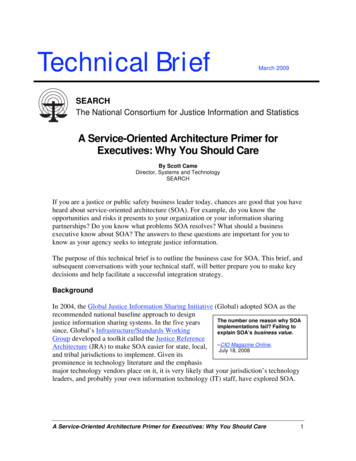
Transcription
Technical BriefMarch 2009SEARCHThe National Consortium for Justice Information and StatisticsA Service-Oriented Architecture Primer forExecutives: Why You Should CareBy Scott CameDirector, Systems and TechnologySEARCHIf you are a justice or public safety business leader today, chances are good that you haveheard about service-oriented architecture (SOA). For example, do you know theopportunities and risks it presents to your organization or your information sharingpartnerships? Do you know what problems SOA resolves? What should a businessexecutive know about SOA? The answers to these questions are important for you toknow as your agency seeks to integrate justice information.The purpose of this technical brief is to outline the business case for SOA. This brief, andsubsequent conversations with your technical staff, will better prepare you to make keydecisions and help facilitate a successful integration strategy.BackgroundIn 2004, the Global Justice Information Sharing Initiative (Global) adopted SOA as therecommended national baseline approach to designThe number one reason why SOAjustice information sharing systems. In the five yearsimplementations fail? Failing tosince, Global’s Infrastructure/Standards Workingexplain SOA’s business value.Group developed a toolkit called the Justice ReferenceMagazine Online,Architecture (JRA) to make SOA easier for state, local, –CIOJuly 18, 2008and tribal jurisdictions to implement. Given itsprominence in technology literature and the emphasismajor technology vendors place on it, it is very likely that your jurisdiction’s technologyleaders, and probably your own information technology (IT) staff, have explored SOA.A Service-Oriented Architecture Primer for Executives: Why You Should Care1
SOA Improves Business AgilityIn a 2006 survey of business executives, CIO Magazine learned that only 11 percent ofCEOs said that their organizations were able to keep up with business demand in areaswhere technology had a significant involvement in service or product delivery. Reversingthat statistic means that almost nine-tenths of executives feel that technology is holdingtheir organizations back, because it cannot change fast enough. Business leaders andoperational managers come up with good ideas for process improvement or opportunitiesto expand service offerings. These ideas are often shelved or scaled back because thetechnology cannot adapt quickly or efficiently enough to support them. Most executivesexperienced price “sticker shock” or the disappointment when technology projects exceedbudget and timelines.Information sharing is the lifeblood of the justice system. The very premise for how lawenforcement, prosecutors, the judiciary, corrections, and other agencies work together istheir ability to share information. In the past several years, state, local, and tribaljurisdictions invested considerable resources in automating these information flows toincrease productivity throughout the justice system.Many of these jurisdictions have learned that without employing SOA principles, linkinginformation systems together across organizational boundaries can result in unwanteddependencies. These dependencies occur at two levels: Technology Dependencies. If a single vendor, technology platform, databaseproduct, or solution is adopted by all participating organizations, then individualagencies generally have to change their internal systems to fit. Not only is thisfinancially costly, but it also reduces your ability to manage internal operationswithout impact to the other partners. Changes to partner operations may alsoaffect your system. Business Process Dependencies. Also called “building a one-off.” Anautomation project that focuses only on the immediate process will result in futureproject delays. Without considering the potential for reuse in the future,development efforts will take longer, cost more, and create significant operationaloverhead. If the semantics of an automated information exchange—the definitionof the data and how it is structured—are driven by one agency’s internal datamodel or business process to the exclusion of the others’, the participatingagencies have more work to do to “translate” the information into a formmeaningful to them.A Service-Oriented Architecture Primer for Executives: Why You Should Care2
In both cases, and after several tactically successful projects to implement informationexchanges, the inter-system connection points in a jurisdiction can wind up looking like arat’s nest, as shown in Figure 1.Figure 1Given the autonomy with which justice and public safety organizations traditionallyoperate, these unwanted (and unnecessary) dependencies pose serious challenges for ajurisdiction’s information sharing approach. Unlike most private sector organizations,state or local government agencies have considerable control and latitude over theirinternal business processes and technology choices. This autonomy allows each agency tooptimize processes and technology to suit its unique stakeholder base, legal requirements,and traditional roles. However, agency autonomy coupled with the one-off approach canexacerbate the negative impact of unnecessary business process and technologydependencies. These dependencies can infringe on the ability of agencies to maintaintheir own processes and technologies and create operational challenges for multipleapplications.SOA provides a set of methodologies, techniques, and technical standards that avoidthese pitfalls. The details of these SOA elements are beyond the scope of this technicalbrief, and are really the domain of your technology staff. However, it is important for thebusiness executive to know that brittleness and fragility are potential outcomes ofautomated information sharing initiatives that do not adopt an SOA approach.A Service-Oriented Architecture Primer for Executives: Why You Should Care3
Sharing of InfrastructureIn today’s climate, in which state, local, and tribal governments face severe fiscalconstraints, the customary need to economize on resources takes on even greatersignificance. It is simply not financially feasible for every agency or project to procure,deploy, and maintain its own tools and technologies for automating information flow.However, for shared infrastructure to work, the infrastructure must be based on openindustry standards. This avoids the need for every justice and public safety agency tochoose the same technology vendors, platforms, tools, and so on. These standardsdescribe the ways in which tools from different vendors will interact. The standards arereferred to as open industry standards because they are developed by cooperative effortsamong leading technology vendors. Buying information sharing infrastructure thatconforms to open industry standards is an important component to ensure that yourinformation exchanges will interoperate with future systems and meet future needs with aminimum of adaptation and change. Open industry standards also provide a neutralplaying field that avoids favoring one vendor over another. This, in turn, supports fairtechnology procurements and enhances partners’ autonomy to make optimal choices fortheir internal technology needs while simultaneously supporting common goals.SOA encompasses a broad set of open industry standards to guide the acquisition andimplementation of information sharing infrastructure. It includes best practices that yourtechnology staff do not have to discover for themselves. SOA can accelerate establishinginfrastructure, and encourage agencies to share it once it is in place because it provides aclear roadmap for infrastructure tools and technologies, describes how they fit together,and what they need to do. Ultimately, these reduce long-term costs, increase systemflexibility, and preserve your agency’s autonomy.An SOA Action PlanSo if the justice business leader finds agility and increased sharing of technologycompelling, what are the steps he or she should follow in moving down the SOA path?The following action items should be among the priorities for any organization seeking toadopt SOA. Understand that SOA is primarily about setting technology standards.Adopting SOA is not about buying technology—servers, tools, gadgets, orsoftware. It is about setting standards for how the organization’s technologistswill build solutions that link systems together. The justice business leader shouldchallenge any message coming from IT staff or vendors that purchasing an “SOAsuite” or “enterprise service bus” will propel the organization toward the SOApromised land. Adopting SOA is about consciously choosing behaviors for the ITpractitioners (and their industry partners) that have proven effective at producingincreased agility and improved sharing of infrastructure assets. The standardsincluded within an SOA will include basic technical standards such as webservices and the National Information Exchange Model (NIEM), but also muchmore, such as:A Service-Oriented Architecture Primer for Executives: Why You Should Care4
o Methodologies for identifying services that explicitly address strategicbusiness goalso Standards for the design and specification of services to maximize reuseo Governance processes that clarify the many roles and responsibilitiesnecessary for proper sharing and reuse of services and infrastructureo Required infrastructure capabilities. Engage a qualified architect. The body of technology standards that constitutean SOA will collectively form the organization’s architecture for informationsharing. Developing an architecture requires skill and experience, as well as abalance between technology savvy and the ability to promote SOA, buildconsensus, communicate effectively, and manage the architecture developmentproject. In the right hands, development of an SOA can take as little as severalweeks. Acquire infrastructure products after establishing the architecture. Once anorganization establishes an architecture, it will likely become apparent that someinvestments in technology will be necessary to enable the partners to conform tothe standards. These purchasing decisions should be based on requirementsexplicitly identified in the architecture. In fact, architecture conformance shouldbe a principal requirement in the request for proposals (RFP) or otherprocurement documents for infrastructure tools. The business leader shouldexpect to find a robust market for SOA support tools, including viable opensource tools that involve no up-front licensing cost. While an organization’s ITdepartment may have established preferred vendors for core technologies, such asdatabases and application servers, it is important to recognize that any SOAsupport product will be new to the organization and will require some degree ofintegration with these other tools. Organizations should strongly consider a “bestof breed” approach that includes open source when acquiring SOA infrastructure. Leverage the Global JRA to accelerate adoption. The Global JRA providesseveral benefits to the justice organization seeking to adopt SOA. It providesbaseline documents for all the necessary standards, which the organization cantailor to meet specific local requirements. These baseline documents have resultedfrom bringing best practices and lessons learned from state and local practitionerswho have pioneered SOA adoption in a justice environment. In addition, the JRAdocuments provide off-the-shelf alignment with national justice standards, such asNIEM and the Global Federated Identity and Privilege Management (GFIPM)initiative. As a result, leveraging the JRA can save a state or local jurisdictionsignificant time and effort in adopting SOA, while ensuring alignment withnational strategies.A Service-Oriented Architecture Primer for Executives: Why You Should Care5
Support the SOA effort by engaging other leaders. For many justice agenciesand partnerships, SOA will represent a significant change in behavior, especiallyfor the IT sections of each partner agency. In the short term, SOA will almostcertainly require additional effort, time, and resources—in short, a sacrifice. Thisis where an executive’s leadership abilities are crucial. Effective communicationof the ultimate vision and fostering agreement on the outcomes are very importantjobs for a leader to take on. Establish an SOA Center of Excellence. Gartner, Forrester, and othertechnology research firms have long recognized that an SOA Center ofExcellence (COE) is a key enabler of SOA success. SOA is basically anintegration strategy grounded in technology standards. As such, it tends to involvedifferent justice partners at different times, depending on tactical project needs. Itis generally inefficient for each agency, even in a large state governmentenvironment, to maintain the expertise needed to support an SOA. Additionally,since the success of SOA requires all partners to agree to follow certain standards,it is important to establish a centralized group to work with project teams,vendors, and other technologists in the partner agencies to ensure conformancewith the standards and maximum reuse of infrastructure. Initially, this centralgroup can consist solely of the SOA architect, but as the architecture expands andgoverns more information exchanges, the COE will likely need to grow with it. Demand to see results, but give it time. TheNeed to learn how tojustice business leader should insist onmeasure SOA improvemeasurement of how the SOA is making thements? See Laworganization more agile and cost-effective. TheEnforcement Tech Guidefor Creating Performancedifficulty with measuring the agility impact ofMeasures that WorkSOA is that it is often not felt for some time, soinitially the focus should be on adoption acrossthe justice enterprise. Over time, outputmeasures can transition to outcome measures—cost savings and reduced time toaccommodate policy changes—once the opportunity to observe these outcomesarises.ConclusionThis brief suggests that SOA provides two key business benefits—business agility andsharing of infrastructure—that should be important elements of any justice and publicsafety information sharing effort. While the executive leader’s job is not to develop orimplement SOA, it is the leader’s job to understand and approve the business rationalefor any significant technology investment.A Service-Oriented Architecture Primer for Executives: Why You Should Care6
The fundamental business purpose of SOA is to minimize unnecessary dependencies(technical and business process) and enable common infrastructure, thereby transformingthe rat’s nest of information exchanges into a more manageable, sustainable approach, asshown in Figure 2.SOAMethodologies,Techniques, andInfrastructureFigure 2To request technical assistance with SOA implementation in your jurisdiction, visithttp://www.search.org/products/ta/.This project was supported by funding from the U.S. Department of Justice Bureau of JusticeAssistance. Points of view or opinions contained in this document are those of the author anddo not necessarily represent the official position or policies of the U.S. Department of Justice.Francis X. Aumand IIChairmanRonald P. HawleyExecutive DirectorKelly J. PetersDeputy Executive DirectorSEARCH7311 Greenhaven Drive, Suite 145 Sacramento, CA 95831(916) 392-2550 (916) 392-8440 (fax) www.search.orgA Service-Oriented Architecture Primer for Executives: Why You Should Care7
A Service-Oriented Architecture Primer for Executives: Why You Should Care 4 Sharing of Infrastructure In today’s climate, in which state, local, and tribal governments face severe fiscal constraints, the customary need to economize on resources takes on even greater significance. It is simply not financially feasible for every agency or .

